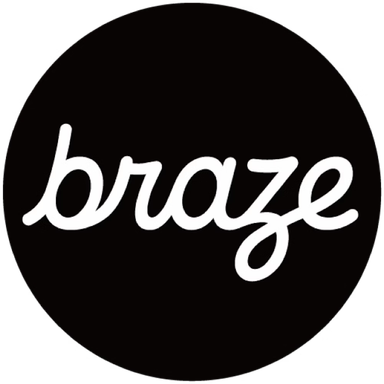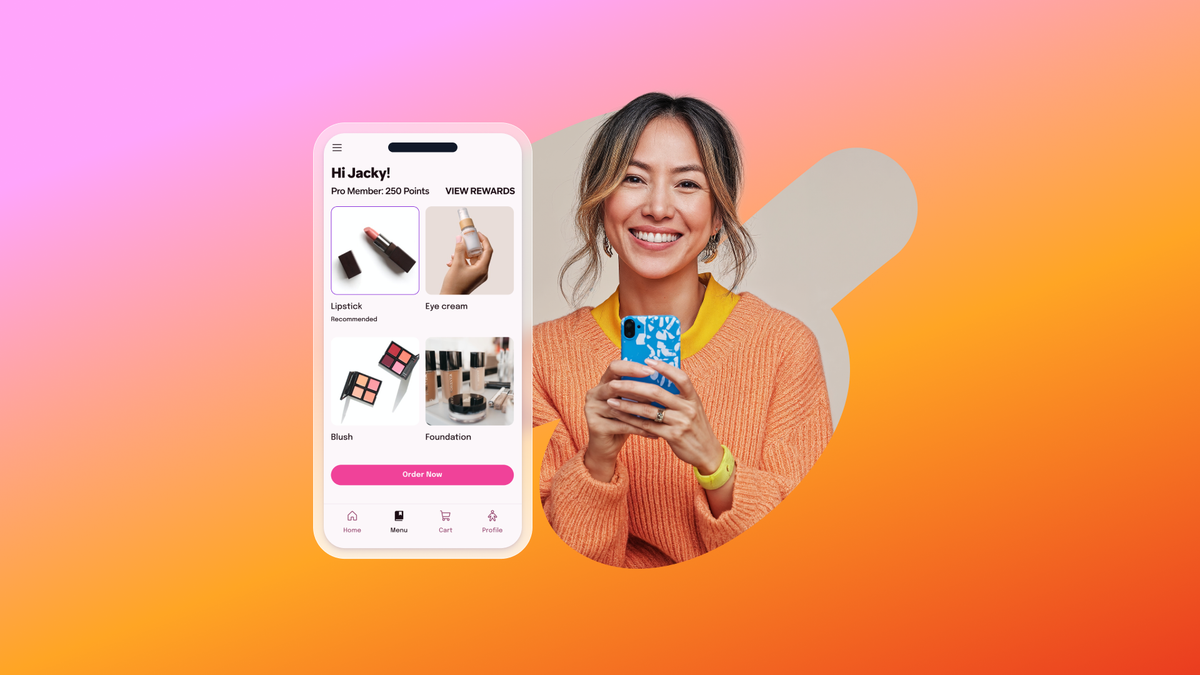B2C Personalization: How to Create Consumer Experiences That Drive Loyalty
Published on October 13, 2025/Last edited on October 13, 2025/13 min read


Team Braze
BrazeBusiness-to-consumer (B2C) personalization means shaping messages, offers, and moments around the individual consumer as they move from onboarding to loyalty. It’s using what you know, whether it’s preferences, behavior, or context, to make every interaction feel helpful across email, push, SMS, in-app, and web.
In B2C, speed and scale matter. Customers make fast decisions, signals change by the minute, and audiences can reach numbers in the millions. That raises the bar for real-time decisions, consistent omnichannel delivery, and simple ways to measure what’s working. For teams building personalized marketing for B2C, achieving both speed and scale is nonnegotiable.
This guide covers the essentials: a clear definition and B2C vs. B2B (business-to-business) contrast, what consumers expect, the core consumer personalization strategies you can adopt, and examples of B2C personalization from the retail industry, streaming/media services, quick service restaurants (QSR), and apps. We’ll walk through consumer personalization strategies you can adopt now, offering practical moves to pilot and scale. We’ll also tackle common challenges and show how your brand can thrive with the right support in place.
Contents
Why B2C personalization matters
Consumer personalization strategies
3 Real-life B2C personalization use cases
Challenges in B2C personalization
How Braze supports B2C personalization
2 Real-life Examples of B2C Personalization
Final thoughts on B2C personalization
What is B2C personalization?
B2C personalization is when a brand customizes the experience for the consumer across content, products, and services, using consumer data, preferences, and behavior. Brands use these to build messaging, interactions, and engagement that’s meaningful and relevant at a 1:1 level. This kind of relationship can increase trust, satisfaction, loyalty, and influence revenue.
Consumers expect a personalized experience every time they interact with a brand—80% say it’s at least somewhat important when making a purchase. This can look like beginning a greeting by name, providing a product recommendation that actually fits, or a next step shaped by past behavior.
To build long-term loyalty, personalization must feel dynamic, relevant, and consistent across channels. B2C personalization makes that possible by coordinating data, decisioning, and delivery in real time.
How personalized marketing for B2C differs from B2B
In B2C, the goal is to personalize messaging for one person so that decisions happen fast. Brands lean on real-time behavior and preferences, and coordinate high-volume messaging across multiple channels with tight consent and frequency controls.
B2B, on the other hand, targets an account or client with multiple stakeholders, longer cycles, and more approvals. It adds firmographic data (the B2B version of demographics), and role data to the mix. Marketing efforts rely more on email, content hubs, webinars, and sales-assisted touches—typically at lower volume with deeper content per interaction.
What consumers expect from B2C personalization
Brands that respond in the moment, speak to intent, and keep experiences consistent across channels stand out to consumers, and this builds on what they expect in the future. The customer journey is not linear—the customer lifecycle is a loop—so you must keep consumers engaged and satisfied. This is where customer journey personalization helps, so that new or loyal consumers aren’t left by the wayside.

- Real time: Messages react to behavior in minutes, not days.
- Relevance: Content and offers reflect current intent, past purchases, and stated preferences.
- Omnichannel continuity: Email, push, SMS, in-app, and web work together without repeats or contradictions.
- Control and respect: Clear consent, easy preference management, sensible frequency, and quiet hours.
- Context aware: Location, device, time of day, and lifecycle stage shape both message and timing.
- Value exchange: Personalization saves time, reduces effort, or adds something useful—better recommendations, timely reminders, or meaningful perks.
Example: A shopper views running shoes on their mobile phone. Within minutes, a push notification highlights the exact model in their size. If unopened, an email follows with two close alternatives. After purchase, promos pause, and messages switch to care tips, delivery updates, and a reorder nudge aligned to typical wear cycles.
Why B2C personalization matters
B2C personalization matters because it helps brands show up with the right message at the right moment—standing to move the numbers that most businesses track.
- Retention and CLV: When messages match what people need, they’re more likely to return more often and spend more over time. That can lift retention and customer lifetime value (CLV).
- Lower churn in onboarding and re-engagement: Tailored onboarding can help new customers succeed sooner. Focused win-back messages may address why someone drifted and invite them back.
- Higher engagement and conversion: Providing relevant, timely content can drive more opens and clicks—which can lead to additions to cart, checkouts, and upgrades.
Example: Let’s say a new user skips a key feature. They see a short in-app tip right away. The next day, an email follows with a 30-second how-to. With these timely tips, the brand sees usage climb, and subsequently, the chance of churn lowers. That’s the promise of personalized marketing for B2C—higher engagement, lower churn, and stronger CLV.
Consumer personalization strategies
When it comes to implementing impactful real-time B2C personalization strategies, it can be difficult to know where to start. Begin with the 4 D’s of personalization: Data, Decisioning, Design, and Distribution. Gather the right signals (Data), choose what should happen next (Decisioning), build flexible, modular content (Design), and deliver it on the channels that fit the moment (Distribution). The tactics below put this into action.

Behavioral segmentation
Group customers by what they do—what they browse, buy, and use—and tailor messages to match. RFM (recency, frequency, monetary) and product interest are simple starting points. New buyers might get onboarding tips and a first-purchase offer, while high-value customers may see early access and timely re-order prompts. Keep refining with data-driven personalization and, where helpful, predictive personalization, such as churn risk.
Real-time B2C personalization triggers
Respond to meaningful actions as they happen. Common triggers include abandoned cart, browse abandon, app session drop-off, price drop, and back-in-stock. Begin on the customer’s primary channel and follow up on a secondary channel if needed. Suppress messaging once they convert by adding quiet hours and frequency caps so your outreach stays welcome.
Dynamic content
Dynamic behavior may include swap-in offers, products, and copy based on each person’s profile and behavior. Recommendations can rank items by affinity or availability; offers can reflect loyalty tier or lifecycle stage. Use modular content so the same message renders differently across email, push, SMS, in-app, and web to support true cross-channel engagement without extra production work.
Contextual lifecycle personalization
Adapt timing and content to the moment, wherever the customer is in the lifecycle. You might offer location-aware promos near a physical store or venue; region-based inventory and pricing; mobile-first layouts on phones and richer formats on desktop; weather-based creative; timezone and travel detection to avoid middle-of-the-night sends; shipping cutoffs and local delivery windows; regional holidays and cultural events; commute-time nudges for media; live event tie-ins (games, concerts); and language or locale variants. Layer in lifecycle context, like quiet hours and frequency caps, so messages stay helpful.
3 real-life B2C personalization use cases
These four use cases show personalized marketing for B2C in action across retail, streaming, QSR, and apps, driving conversion, retention, and loyalty. Whether it’s been used for onboarding, win-backs or at some other point in the customer journey, you can take inspiration from these real-life use cases.
1. Ticketek lifts conversions by turning newsletters into personal event picks
Brand: Ticketek
Industry: Retail & eCommerce
Personalization: Weekly emails populate with machine-learning event recommendations for each customer, using first-party preferences and past clicks. Dynamic, API-fed content fills a personalized event array on open; every click feeds back to refine future picks.
Journey outline: Weekly send → personalized events per person → click to event page → next send adapts to new behavior.
Successful outcomes: +228% click-to-convert, +49% tickets sold per open, +260% overall conversion rate on incremental products.
2. Kayo Sports tailors message, channel, and timing to lift reactivation and cross-sell
Brand: Kayo Sports
Industry: Streaming/media
Personalization: A daily, model-driven loop selects the best message, offer, channel, send time, and frequency for each subscriber across email, push, SMS, and in-app. Recommendations are applied through API-triggered journeys, updating as results come in—scaling from a few hundred variants to 1.2 million individualized versions.
Successful outcomes: +14% reactivation within 12 months of churn, +8% average annual occupancy, +105% cross-sell, achieved while the average subscription price rose 20%.
3. CarpeDM personalizes onboarding nudges to increase member engagement and conversion
Brand: CarpeDM
Industry: SaaS/apps (dating)
Personalization: Branching journeys guide members and applicants through a curated funnel. Push prompts members to review new applicants within a set window; email notifies approved applicants when they receive a “like,” inviting a matchmaker consultation. Messaging is personalized by profile, framed and A/B tested, with frequency caps and delays to prevent over-messaging.
Successful outcomes: 84% of members engaged in the review process (goal: 60%), 15% of new customers converted via engagement campaigns (completed consultation and paid for membership).
Challenges in B2C personalization
Personalization tends to break for a few simple reasons: messy handoffs, too many moving parts, or messages that feel too personal. Treat personalization like an ongoing program. Set clear responsibilities, add guardrails, and review the data and journeys on a regular basis.
Data fragmentation and privacy rules
Customer data often sits in lots of places across web, app, point of sale (POS), and support. This makes it hard to cleanly personalize a journey. Work to bring key events and attributes into a single view, and keep consent by channel with timestamps. Give consumers a simple preference center to choose topics they are most interested in and frequency of communication. Collect only what you need, explain why, and respect regional rules.
Scaling personalization across millions of profiles
Scaling is challenging when you try to hand-craft everything. Use reusable content blocks, a small library of decision rules, and a trigger catalog so that teams don’t have to start from scratch. Roll out personalization in phases—one audience, one channel—and then expand to cross-channel engagement. Protect the consumer experience with quiet hours, frequency caps, and conversion-based suppression—and keep an eye on errors and delays.
Avoiding “creepy” personalization
Helpful messaging beats hyper-specific every time. Base messages on recent actions people would expect you to use, avoid sensitive inferences, and say why you’re asking for data. Cap how often you reach out,so that you are not bombarding your audience and stop once someone buys or completes a task. You can then switch to care tips or next steps to help keep the customer within the lifecycle.
How Braze supports B2C personalization
Braze helps teams operationalize consumer personalization strategies by unifying live data, guiding next steps, and delivering across channels without extra lift.
Canvas for real-time journeys
Canvas lets teams build event-based flows that react to what someone just did (or didn’t) and adjust paths in the moment. You can branch on behavior, add holdouts, run tests, and use quiet hours, frequency caps, and conversion-based suppression so real-time B2C personalization stays timely and welcome across email, push, SMS, in-app, and web.
AI and predictive decisioning with BrazeAI Decisioning Studio™
BrazeAI Decisioning Studio™ natively integrates with Braze and provides continuous autonomous experimentation to choose optimal messaging, creative, channel, timing, and frequency of communication for each person. AI decisioning agents use reinforcement learning to improve with every send, moving brands from rules to data-driven personalization and truly 1:1 decisions at scale.
Unified profiles and cross-channel delivery
Braze maintains a live profile that combines web, app, and message activity alongside consent and preferences. Modular content (e.g., Content Blocks, Connected Content) personalizes at send time, supporting smooth cross-channel engagement without duplicating production work and aiding the process with customer journey automation.
2 Real-life examples of B2C personalization
1. 500px grows revenue with localized campaigns
500px is a global community for photographers with users in 190 countries. Language mismatches in marketing were depressing conversions to paid memberships in key regions.
The problem
Siloed messaging systems and English-only campaigns made it hard to target by language or market. Conversions lagged in countries where local language mattered most.

The solution
500px moved to Braze to coordinate email, push, and in-app, and partnered with Alloys partner Amplitude for analysis. The team tested and refined language targeting, adding localized campaigns for Germany and France and validating subject lines with control groups.
The results
- 257% increase in revenue in Germany
- 145% increase in revenue in France
These gains came shortly after the language updates, showing how accurate localization can unlock membership growth in priority markets.
2. Canva scales engagement with personalized emails
Canva is the online design platform used by millions worldwide. During COVID-19, the team needed to communicate quickly and helpfully to a global audience—with messages tailored by interest and language—without harming inbox placement.
The problem
Reach millions with relevant updates during a fast-moving period, lift performance, and keep deliverability strong while localizing content across 20 languages.

The solution
Using Braze, Canva carefully warmed IPs to grow weekly email sends from 30 million to 50 million. The team pulled localized copy via Connected Content (Google Sheet API) so editors could update translations once, then populate campaigns automatically. They launched proven formats first, rolled out in leading markets with mini warm-ups each week, and kept a close eye on daily send ceilings to protect inbox placement.

The results
- 99% deliverability at higher volume
- 33% lift in open rates
- 2.5% increase in platform engagement
- Weekly volume scaled from 30 million to 50 million emails
Final thoughts on B2C personalization
B2C personalization drives loyalty and revenue when it delivers real-time, relevant, omnichannel experiences across the customer lifecycle. Start with clear signals, act at the right moment, and keep messages useful—not noisy. The payoffs show up in engagement, retention, and CLV.
B2C personalization FAQs
What is B2C personalization?
B2C personalization is when a brand customizes experiences for each consumer using data, preferences, and behavior. It tailors messages, offers, and timing across channels at a 1:1 level.
Why is personalization important in B2C marketing?
Personalization is important in B2C marketing because it lifts engagement, conversion, retention, and CLV. It makes every touchpoint more relevant, timely, and useful.
What are examples of B2C personalization strategies?
Examples of B2C personalization strategies include behavioral segmentation, real-time triggers, dynamic content and recommendations, and contextual messaging by location, device, and time of day.
How does B2C personalization differ from B2B personalization?
B2C personalization differs from B2B personalization because it targets individuals with fast decisions and high message volume. B2B targets buying groups, longer cycles, and more sales-assisted touchpoints.
What tools help with B2C personalization?
Tools that help with B2C personalization include a customer engagement platform for journeys and delivery, AI decisioning for next best action, and a unified profile or CDP to keep data current.
How can B2C personalization be scaled across millions of consumers?
B2C personalization can be scaled across millions by unifying profiles, using real-time data pipelines, automating decisions with AI, and orchestrating cross-channel journeys with guardrails like quiet hours and caps.
What are the benefits of B2C personalization for retention and CLV?
The benefits of B2C personalization for retention and CLV include fewer churn moments, more repeat purchases, and higher average order values—compounding into stronger lifetime value.
How does Braze support B2C personalization?
Braze supports B2C personalization by powering real-time journeys with Canvas, unifying profiles for cross-channel delivery, and now integrated with BrazeAI Decisioning Studio™ for predictive decisioning at scale.
Related Tags
Releated Content
View the Blog
B2C Personalization: How to Create Consumer Experiences That Drive Loyalty

Team Braze

Add to Cart Rate: What It Is, Why It Matters, and How to Improve It

Team Braze

Forge 2025: Advancing customer engagement in an AI-native world
